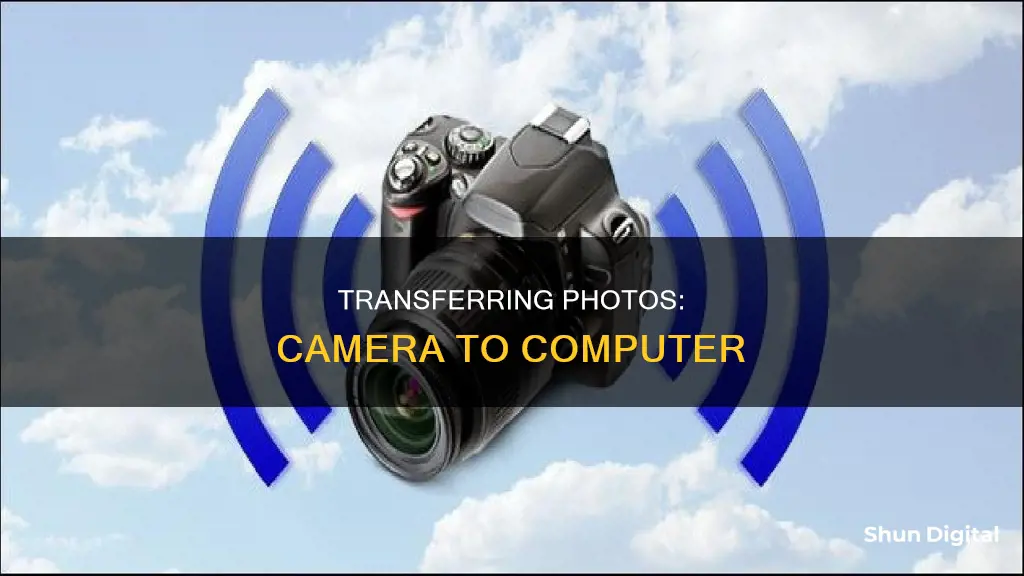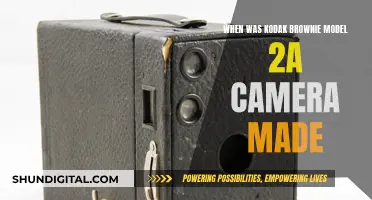
Transferring photos from your camera to your computer is a great way to keep your memories safe and easily accessible. There are several ways to transfer photos, depending on your camera and computer setup. You can use a USB cable, an SD card, or a combination of both.
If your camera uses an SD card, you can simply remove the card from the camera and insert it into your computer's SD card reader, if it has one. From there, you can use your computer's File Explorer or Finder to locate and transfer the photos to your desired location.
If your computer doesn't have a built-in SD card reader, you can purchase an external SD card reader that connects to your computer via USB. This will allow you to transfer photos in the same way as a built-in reader.
Alternatively, you can use a USB cable to connect your camera directly to your computer. First, turn on your camera and connect it to your computer using the USB cable. Then, open the relevant software on your computer, such as the Photos app or File Explorer, to locate and transfer the photos.
By following these methods, you can easily transfer photos from your camera to your computer for safe storage and viewing.
| Characteristics | Values |
|---|---|
| Connection type | USB cable, SD card |
| Computer operating system | Windows, macOS |
| Camera type | Digital camera |
| File type | Photos, videos |
| File location | Internal memory, SD card |
| Transfer method | Drag and drop, import |
What You'll Learn

Using a USB cable (Windows)
To transfer photos from your camera to your Windows computer using a USB cable, follow these steps:
Firstly, ensure that your computer is turned on. Then, use the USB cable that came with your camera to connect it to an open USB port on your computer. If you can't find the port on your camera, check for any panels that can be flipped open. If you don't have the cable, you must purchase a replacement that fits your camera model.
Now, turn on your camera. Your computer should recognise it immediately. You may have to switch the camera into Review mode for it to fully connect to your computer; this process will differ depending on your specific camera model.
You should now see the AutoPlay window pop up. Click the "AutoPlay" box, usually found in the bottom-right corner. Select "Open folder to view files". This will open the File Explorer. Alternatively, you can open this folder manually: right-click the Start menu and click File Explorer, then click your camera device listed on the left panel, and then click SD card.
Now, click DCIM. You may see your photos immediately after clicking your device. In most cases, photos will be in a folder labelled DCIM (Digital Camera Images).
Select the photos you want to transfer. You can transfer individual photos, or press CTRL + A to select all the photos in the folder. To select multiple photos, hold CTRL and click each photo.
Finally, drag the pictures to a new location. You can drag the photos into the Pictures folder, or create a new folder. The amount of time it takes to transfer will depend on the amount of files and your computer's specifications.
If you want to delete the photos from your camera's SD card, wait for the files to finish transferring to your computer. Return to the SD card's folder and press CTRL + A to select all the photos. Right-click the photos, then click Delete.
To eject the camera safely, click the arrow in the bottom-right corner of the taskbar. Click the device icon, and then click Eject. You can now safely unplug the camera from the computer.
Camera Raw Modifications: Non-Destructive and Creative Freedom
You may want to see also

Using a USB cable (Mac)
To transfer photos from a camera to a Mac computer using a USB cable, follow these steps:
Firstly, ensure that your Mac is turned on. Then, locate an open USB port on your computer and use the USB cable that came with your camera to connect it to your computer. If you can't find the USB port on your camera, check for any panels that can be flipped open to reveal it. If your computer or laptop doesn't have a USB-A port, you will need to purchase an adapter.
Once your camera is connected, turn it on. Your computer should recognise it immediately. You may need to switch your camera into Review mode or Play mode for it to be fully recognised by your computer. This process will differ depending on your specific camera model, so refer to your camera's manual for further instructions.
Now, open the Photos app on your Mac. This app looks like a multi-coloured flower. Within the Photos app, select the photos that you want to transfer by clicking on each photo. You can also drag your cursor to select multiple photos at once.
After you have selected the photos, click on "Import Selected" in the Photos app. You can also click "Import All New Photos" in the top-right corner of the app. Imported photos will be saved to "All Photos". If you want to change the save location, click the drop-down menu next to "Import to" and select a new destination.
Finally, eject your camera before disconnecting it from your computer. To do this, open the Finder on your Mac, locate the camera in the left sidebar, and then click the up-arrow icon to eject it. Now, you can safely disconnect the camera from your computer.
Replacing the Battery in Your Kangaroo Doorbell Camera
You may want to see also

Using an SD card (Windows)
Firstly, you will need to remove the SD card from your camera. Open the panel that contains the internal storage, then press the SD card to unlock it from your camera.
Next, insert the SD card into your computer's card reader. If your computer doesn't have a built-in card reader, you can purchase an external SD card reader that connects via USB.
Now, open the File Explorer. Right-click the Start menu and click File Explorer.
Click on your SD card. You can find this in the left panel. If you don't see it, click the arrow on the left of This PC to expand the options.
If you don't see the photos immediately, double-click the DCIM folder.
Select the pictures you want to transfer. You can transfer individual photos, or press CTRL + A to select all the photos in the folder. To select multiple photos, hold CTRL and click each photo.
Finally, drag the pictures to a new location. You can drag the photos into the Pictures folder, or you can create a new folder. The amount of time it takes to transfer will depend on the amount of files and your computer.
If you want to delete the photos from your camera's SD card, wait for the files to finish transferring to your computer. Return to the SD card's folder and press CTRL + A to select all the photos. Right-click the photos, then click Delete.
To eject the SD card, click the arrow in the bottom-right corner of the taskbar. Click the flash drive icon, and then click Eject. You can now insert the SD card back into the camera.
Breaking Surveillance Cameras: Effective Strategies for Privacy Protection
You may want to see also

Using an SD card (Mac)
To transfer photos from your camera to your Mac using an SD card, you'll first need to check that your Mac has an SD card slot. If it doesn't, you'll need to purchase an external SD card reader.
Once you have confirmed that your Mac has an SD card slot, or you have purchased a reader, follow these steps:
- Ensure that the lock switch on the SD card is turned off.
- Insert the SD card into the SD card slot on your Mac, or into your external card reader.
- Open the Photos app on your Mac.
- In the sidebar on the left-hand side of the screen, locate the 'Import' heading. Underneath this heading, you will see your SD card's name; click on it.
- If your SD card doesn't show up in the sidebar, click on 'File' in the toolbar and select 'Import' from the drop-down menu. A Finder pop-up window will appear, where you can select your SD card and choose the images you want to import.
- Once you have selected the images you want to import, click 'Review for Import'.
- Choose where you would like to import the images to by clicking on the 'Album' pop-up menu and selecting a location.
- If you want to import all the new photos on your SD card, click 'Import All New Photos'. To select specific photos, click on the photos you want to import and then click 'Import Selected'.
- If you want to delete the photos from your SD card after importing them, click 'Delete Items'. If you want to keep the photos on your SD card, click 'Keep Items'.
- When the import is complete, eject the SD card from your Mac or card reader.
Your imported photos will now appear in the Imports and Library albums in the sidebar.
Surveillance Cameras: Strategic Placement for Maximum Security
You may want to see also

Using a USB to SD adapter
If your computer has a built-in SD card reader, transferring photos from your camera to your computer is a straightforward process. If your computer does not have a card reader, you will need to purchase an external SD card reader that connects to your computer via USB.
To transfer photos using an SD card reader:
- Turn on your computer.
- Remove the SD card from your camera. Open the panel that contains the internal storage, then press the SD card to unlock it from your camera.
- Insert the SD card into your computer's card reader or external card reader.
- Open the File Explorer on your computer. On a Windows computer, you can do this by right-clicking the Start menu and selecting File Explorer. On a Mac, open the Finder, which can be found on the dock.
- Locate your SD card in the left panel of the File Explorer or Finder window. If you don't see the photos immediately, double-click the DCIM folder.
- Select the pictures you want to transfer. You can transfer individual photos or select all the photos in the folder by pressing Ctrl + A on a Windows computer or Cmd + A on a Mac. To select multiple photos, hold Ctrl or Cmd and click each photo.
- Drag the selected pictures to a new location on your computer, such as the Pictures folder or a new folder.
- If you want to delete the photos from your camera's SD card, wait for the files to finish transferring. Then, return to the SD card's folder and select all the photos by pressing Ctrl + A or Cmd + A. Right-click the photos and select Delete or drag them to the Trash/Bin.
- Eject the SD card from your computer. On a Windows computer, click the arrow in the bottom-right corner of the taskbar, then click the flash drive icon and select Eject. On a Mac, find the SD card listed on the left panel of the Finder and click the up-arrow symbol to eject it safely.
Using an SD card to transfer photos from your camera to your computer is a quick and easy process. By following the steps outlined above, you can efficiently transfer, organise, and store your photos on your computer.
Vivint Doorbell Camera: Battery or Wired?
You may want to see also
Frequently asked questions
The easiest way will depend on your camera and computer setup. If your camera uses an SD card, you can simply remove it from the camera and insert it into your computer's SD card slot. If you don't have a built-in card reader, you can purchase an SD card reader that connects to your computer via USB. From there, you can transfer photos by dragging and dropping them into a folder on your computer.
First, turn on your computer and your camera. Connect your camera to your computer using the USB cable that came with your camera. If you don't have the original cable, you'll need to purchase a compatible replacement. Once your camera is connected, switch it into Review mode. On your computer, open the Photos app and select the photos you want to transfer. Then, click "Import" to transfer the selected photos. Finally, eject your camera before disconnecting it from your computer.
Check to see if your camera appears as a drive in your file manager program. If your camera uses a memory card, try removing the card and using a USB card reader to connect it to your computer. If neither of these solutions work, you may need to replace your camera cable.
If your camera uses a memory card, make sure the memory card is inserted into the camera. Then, connect your camera to your computer using a USB cable. On your computer, open the File Explorer or Finder and locate your camera or memory card in the left panel. From there, you can navigate to the DCIM folder, select the photos you want to transfer, and drag them to a new location on your computer.
Yes, some cameras support wireless transfer. However, the process may vary depending on your camera model. Refer to your camera's user manual for specific instructions.







